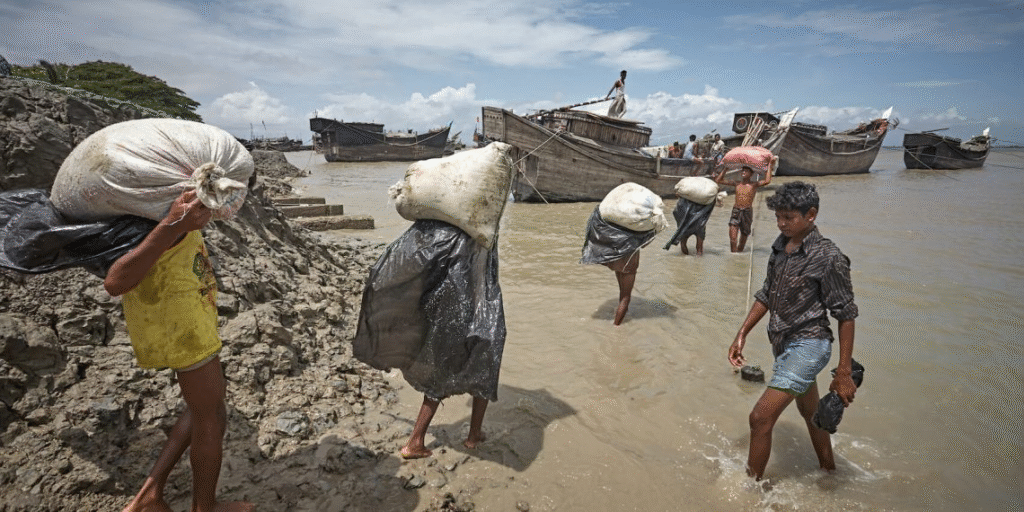
Definition and Types
For many refugees, climate change is a reality of displacement, a factor that makes their survival that much harder-won. Rohingya refugees in climate-affected Bangladesh face the impacts of the crisis on the country, especially in increasingly severe monsoon seasons that flood camps and destroy temporary homes. The effects of climate change in Lebanon, from water stress to harsh winters, mean that over 750,000 Syrian refugees suffer biting cold spells and struggle to get clean and safe water on a regular basis.
However, climate change is not only a challenge faced by refugees. It’s also a leading cause of forced displacement, and one that we often ignore. They’ve been called “environmental refugees,” “the world’s forgotten victims,” and “the refugees the world barely pays attention to.” Here’s what you need to know about climate refugees.
Climate refugees are individuals forced to leave their homes and communities due to the effects of climate change and global warming. They belong to the broader category of environmental migrants who are displaced by environmental degradation and natural disasters. However, it is important to note that there is no clear legal definition of a 'climate refugee,' nor are climate refugees covered by the 1951 Refugee Convention The concept of 'climate refugee': Towards a possible definition | Think Tank | European Parliament, which traditionally recognizes only those fleeing persecution based on race, religion, nationality, social group membership, or political opinion.
Climate refugees can be categorized into several types based on displacement patterns: internal climate migrants who move within their own countries, cross-border climate migrants who relocate internationally, temporary displaced persons affected by acute weather events, and permanent migrants from areas rendered uninhabitable by long-term climate impacts such as sea-level rise or desertification.
Current Statistics and Projections
The scale of climate-induced displacement is staggering and growing. Climate-related hazards like floods, storms, and wildfires played a role in 26.4 million displacements in 2023 Climate change and human mobility | Migration data portal. More specifically, in 2023, 491,000 internal displacements were recorded globally due to droughts alone Environmental Migration. The vulnerability of displaced populations is particularly concerning, as by mid-2024, around 90 million of the current 123 million forcibly displaced people are living in countries with high-to-extreme exposure to climate-related hazards, representing an increase of around 5 million since the end of 2023 How climate change impacts refugees and displaced communities.
The intersection of climate vulnerability and refugee status is significant. In 2022, 84% of refugees and asylum seekers fled from countries highly vulnerable to climate change Refugees | United Nations, demonstrating how climate impacts compound existing humanitarian crises. Looking forward, projections suggest the crisis will intensify dramatically, with estimates indicating up to 1.2 billion people could become climate refugees by 2050 if current warming trends continue.

Legal and Policy Challenges
Despite the growing crisis, significant legal gaps remain. The UN Human Rights Council found that many people forced from their homes due to climate change effects do not fit the traditional definition of refugees Global health, climate change and migration: The need for recognition of “climate refugees” - PMC. However, progress is being made through frameworks like the Global Compact on Safe, Orderly and Regular Migration adopted in 2018, which encourages governments to develop visa options and planned relocation strategies for climate-displaced persons when return to their origin countries is not feasible.
Conclusion
Climate refugees represent one of the most pressing humanitarian challenges of the 21st century, requiring urgent international cooperation, legal framework development, and comprehensive climate action to address both the root causes and humanitarian consequences of climate-induced displacement.
References
Internal Displacement Monitoring Centre (IDMC). (2024). Global report on internal displacement. https://www.internal-displacement.org
Migration Data Portal. (2024). Environmental migration. International Organization for Migration. https://www.migrationdataportal.org/themes/environmental-migration
United Nations High Commissioner for Refugees. (2024). How climate change impacts refugees and displaced communities. https://www.unrefugees.org/news/how-climate-change-impacts-refugees-and-displaced-communities/
United Nations. (2022). Refugees. Global Issues. https://www.un.org/en/global-issues/refugees

